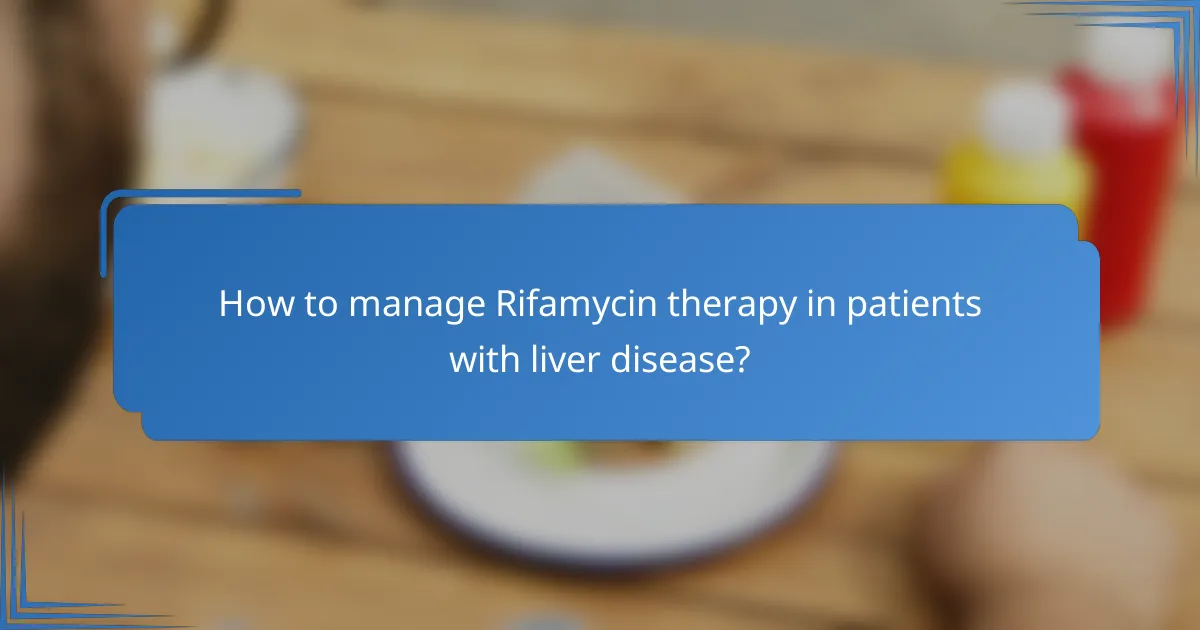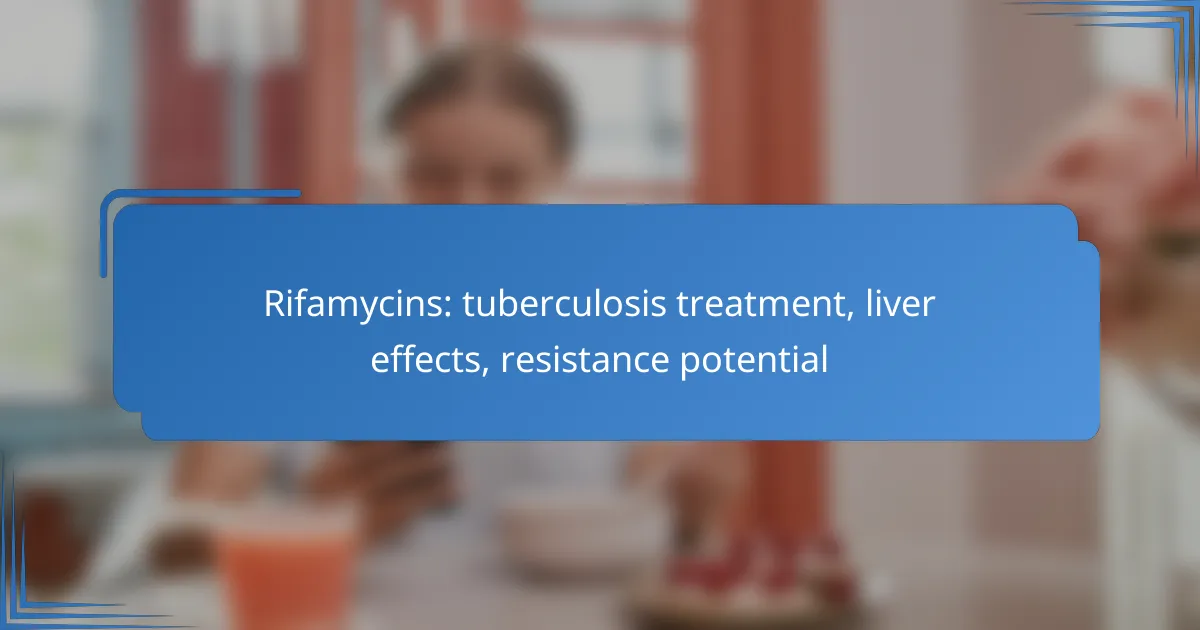Rifamycins, including Rifampicin, Rifabutin, and Rifapentine, are essential in the treatment of tuberculosis (TB) in Canada. While effective against TB, these medications necessitate careful monitoring of liver function due to their potential hepatotoxicity and the risk of developing resistance, which can complicate treatment outcomes. Understanding these factors is vital for optimizing therapy and ensuring patient safety.

What are the treatment options for tuberculosis with Rifamycins in Canada?
In Canada, Rifamycins are key components in the treatment of tuberculosis (TB), primarily including Rifampicin, Rifabutin, and Rifapentine. These medications are effective in combating TB but require careful consideration of their effects on the liver and potential for resistance.
Rifampicin
Rifampicin is a cornerstone in TB treatment, often used in combination with other antibiotics. It works by inhibiting bacterial RNA synthesis, effectively reducing the bacteria’s ability to multiply. Patients typically take Rifampicin daily for six months as part of a standard regimen.
Monitoring liver function is crucial while on Rifampicin, as it can cause hepatotoxicity in some individuals. Regular blood tests are recommended to detect any liver issues early, especially in patients with pre-existing liver conditions.
Rifabutin
Rifabutin is an alternative to Rifampicin, particularly for patients co-infected with HIV, as it has a lower potential to interact with antiretroviral therapies. It also inhibits bacterial RNA synthesis but is generally better tolerated in terms of liver effects.
While Rifabutin is effective, it may require dosage adjustments based on the patient’s overall health and concurrent medications. Regular monitoring is still advised to ensure efficacy and minimize side effects.
Rifapentine
Rifapentine is used primarily in the treatment of latent TB and is often administered in a once-weekly regimen. This can enhance patient adherence due to the reduced frequency of doses compared to daily options.
Like other Rifamycins, Rifapentine can affect liver function, so monitoring is essential. It is typically used in combination with isoniazid for latent TB treatment, and healthcare providers should evaluate the patient’s liver health before starting therapy.

How do Rifamycins affect liver function?
Rifamycins can impact liver function by potentially causing hepatotoxicity, which may lead to elevated liver enzymes and other liver-related issues. Understanding these effects is crucial for managing treatment and ensuring patient safety.
Hepatotoxicity risks
The use of Rifamycins, particularly Rifampicin, carries a risk of hepatotoxicity, which can manifest as liver damage or dysfunction. Factors such as pre-existing liver conditions, concurrent use of other medications, and alcohol consumption can increase these risks.
Symptoms of hepatotoxicity may include jaundice, fatigue, and abdominal pain. Regular assessment of liver health is essential for patients on Rifamycins to mitigate these risks and ensure timely intervention if needed.
Monitoring liver enzymes
Monitoring liver enzymes is a critical component of treatment with Rifamycins. Healthcare providers typically recommend baseline liver function tests before starting therapy and periodic follow-up tests during treatment.
Common liver enzymes to monitor include alanine aminotransferase (ALT) and aspartate aminotransferase (AST). Elevated levels may indicate liver stress, prompting a reassessment of the treatment plan or dosage adjustments.

What is the resistance potential of Rifamycins?
The resistance potential of Rifamycins, particularly in treating tuberculosis, is significant due to the ability of Mycobacterium tuberculosis to develop mutations that confer resistance. This resistance can complicate treatment regimens and lead to treatment failures, making understanding the mechanisms and impacts essential for effective therapy.
Mechanisms of resistance
Resistance to Rifamycins primarily arises through mutations in the rpoB gene, which encodes the beta subunit of RNA polymerase. These mutations can alter the drug’s binding site, reducing its efficacy. Other mechanisms may include the overexpression of efflux pumps that expel the drug from bacterial cells.
Additionally, the presence of biofilms can protect bacteria from antibiotic action, allowing resistant strains to persist in the body. Understanding these mechanisms helps in tailoring treatment approaches to combat resistance effectively.
Impact on treatment efficacy
The emergence of resistance can significantly reduce the efficacy of Rifamycins, leading to longer treatment durations and the need for alternative medications. In cases of multidrug-resistant tuberculosis (MDR-TB), the standard Rifamycin-based regimens may no longer be effective, necessitating the use of more toxic and less effective second-line drugs.
Healthcare providers must monitor treatment responses closely and consider susceptibility testing to guide therapy decisions. Early detection of resistance can help in adjusting treatment plans and improving patient outcomes, especially in regions with high rates of tuberculosis and resistance.

What are the side effects of Rifamycins?
Rifamycins can cause a range of side effects, from mild to severe, impacting various bodily systems. Understanding these effects is crucial for effective tuberculosis treatment and monitoring patient safety.
Common side effects
Common side effects of Rifamycins include gastrointestinal disturbances such as nausea, vomiting, and diarrhea. Patients may also experience fatigue, headaches, and a reddish-orange discoloration of bodily fluids, including urine and sweat.
These side effects are generally manageable and may diminish as the body adjusts to the medication. However, patients should report persistent or severe symptoms to their healthcare provider.
Serious adverse reactions
Serious adverse reactions to Rifamycins can include liver toxicity, which may manifest as jaundice, dark urine, or elevated liver enzymes. Regular monitoring of liver function tests is recommended for patients on long-term therapy.
Other serious reactions may involve severe allergic reactions, such as anaphylaxis, or hematological issues like thrombocytopenia. Immediate medical attention is necessary if any signs of these serious conditions occur.

How to manage Rifamycin therapy in patients with liver disease?
Managing Rifamycin therapy in patients with liver disease requires careful monitoring and potential adjustments to dosing. Liver function can significantly impact the metabolism of Rifamycins, necessitating a tailored approach to treatment.
Dosing adjustments
Dosing adjustments for Rifamycins in patients with liver disease are critical to avoid toxicity. Generally, it is recommended to start with lower doses and closely monitor liver function tests. For patients with moderate to severe liver impairment, reducing the dose by 50% may be necessary, but this should be guided by clinical response and tolerance.
Regular monitoring of liver enzymes is essential during therapy. If enzyme levels rise significantly, consider temporarily discontinuing the medication or further reducing the dose until levels stabilize.
Alternative therapies
If Rifamycin therapy is not feasible due to liver disease, alternative treatments for tuberculosis should be considered. Options such as ethambutol or fluoroquinolones may be used, but they also require careful evaluation of liver function and potential side effects.
Consultation with an infectious disease specialist can help determine the best alternative regimen. In some cases, a combination of therapies may be necessary to effectively manage tuberculosis while minimizing liver strain.

What are the guidelines for Rifamycin use in Canada?
In Canada, guidelines for Rifamycin use focus on its effectiveness in treating tuberculosis while considering potential liver effects and resistance. Healthcare providers must adhere to established recommendations to ensure safe and effective treatment.
Public Health Agency of Canada recommendations
The Public Health Agency of Canada emphasizes that Rifamycins, particularly Rifampin, are essential in the treatment of active tuberculosis. They recommend regular monitoring of liver function tests, especially in patients with pre-existing liver conditions or those taking other hepatotoxic medications.
Patients should be educated about possible side effects, including liver toxicity and the risk of drug interactions. The Agency advises that healthcare providers assess the risk-benefit ratio before initiating treatment with Rifamycins.
Clinical practice guidelines
Clinical practice guidelines in Canada recommend using Rifamycins as part of a multi-drug regimen for tuberculosis, typically alongside isoniazid, pyrazinamide, and ethambutol. Treatment duration usually spans six months, but this may vary based on individual patient factors.
Healthcare professionals should monitor patients for signs of resistance, particularly in cases of incomplete adherence to the treatment regimen. Regular follow-ups and adherence support are crucial to minimize the risk of developing drug-resistant tuberculosis.

What are the emerging trends in Rifamycin research?
Emerging trends in Rifamycin research focus on developing new formulations and understanding their effects on treatment efficacy and resistance. Researchers are exploring innovative delivery methods and combinations to enhance the effectiveness of Rifamycins against tuberculosis.
New formulations
New formulations of Rifamycins aim to improve patient adherence and treatment outcomes. For instance, extended-release formulations allow for less frequent dosing, which can enhance compliance among patients who may struggle with daily medication regimens.
Additionally, researchers are investigating combination therapies that pair Rifamycins with other antitubercular agents. This approach not only targets tuberculosis more effectively but also helps in mitigating the development of drug resistance.
Another trend is the use of nanotechnology to create targeted delivery systems for Rifamycins. These systems can potentially increase drug concentration at the infection site while minimizing systemic side effects, particularly on the liver.
